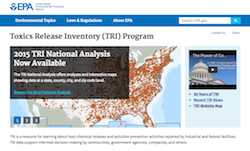SEJournal Online is the digital news magazine of the Society of Environmental Journalists. Learn more about SEJournal Online, including submission, subscription and advertising information.
A short video introduction to the Toxics Release Inventory, courtesy the U.S. EPA
Reporter’s Toolbox: Toxics Database a Key Tool for Environmental Journalists
By Joseph A. Davis
What toxic chemicals are being released into the air and water in your area? An annual collection of data by the U.S. Environmental Protection Agency can help environmental journalists answer that question. And a new edition was just issued in Jan. 12, 2017 by the outgoing Obama administration.
The Toxics Release Inventory, or TRI, helped reporters do data journalism since before it was cool. Congress passed a law in 1986 — in response to the 1984 Bhopal disaster in India that killed thousands — requiring companies to report their releases of toxic chemicals and requiring EPA to make that information public online.
It’s important to note that environmental health advocates can not be assured that the data’s integrity will be preserved under a Trump administration determined to reduce EPA's role, perhaps dramatically.
Could TRI be destroyed, and if so, how? A template can be found back in the George W. Bush administration, which, with the chemical industry cheering it on, diminished the amount of information available from TRI and eroded it severely. SEJ opposed those changes at the time. The Obama administration later substantially restored TRI.
Lens to zoom in on industries, companies, more
 |
| TRI data is available through the EPA web site at https://www.epa.gov/toxics-release-inventory-tri-program |
Environmental journalists can use the TRI (which now contains almost three decades of data) to track trends in toxic chemical handling and emissions nationwide. But it is also a powerful lens for zooming in on particular industries, particular companies, and particular states, regions or localities.
If you are new to covering the environmental beat, it is a quick way to find out “where the bodies are buried” — that is, what industrial facilities are handling large amounts of potentially dangerous chemicals near you, and how they are disposing of them.
Note that most of the toxic “releases” it records are legal — those made under EPA air or water pollution-control permits, put in regulated landfills, turned into other materials or used in manufacturing.
TRI data are online, mapped and searchable in many ways. In a good year, EPA makes it easy to localize the story TRI tells — by breaking out state-by-state analyses so you don’t have to do the data crunching. Look at EPA latest press releases for the Jan. 12 release.
If you are a data geek, you can download the entire data set. Because collecting, vetting and organizing data for the previous year is a lot of work, there is a time lag. The January 2017 update covers chemicals that were released over the year 2015.
Importance of ground-truthing TRI data
Some caveats. Data reporting needs to be supplemented and contextualized with other kinds of reporting. Data can be wrong, so ground-truthing is always needed.
Also, TRI does not cover all the toxic threats. What really matters is not raw data about chemicals handled, but actual human exposure (which TRI does not measure) and the health consequences of that exposure (EPA has other tools for investigating these things).
The TRI is the foundation of many other EPA data resources on toxic substances. In recent years, EPA has made a lot of progress linking TRI to other data resources. By linking it to mapped demographic data, for example, EPA has produced environmental justice tools for describing how toxics impact minority communities.
Two other tools for localizing and extending TRI data are EPA’s Community-Focused Exposure and Risk Screening Tool and its Risk-Screening Environmental Indicators model. If you work with TRI data, it is now much less difficult to relate it to other EPA data sets on air, water and solid/hazardous waste permits.
Joseph A. Davis is editor of WatchDog Tipsheet, and writes the weekly Tipsheet and monthly Issues Backgrounders.
* From the weekly news magazine SEJournal Online, Vol. 2, No. 8. Content from each new issue of SEJournal Online is available to the public via the SEJournal Online main page. Subscribe to the e-newsletter here. And see past issues of the SEJournal archived here.













 Advertisement
Advertisement 



